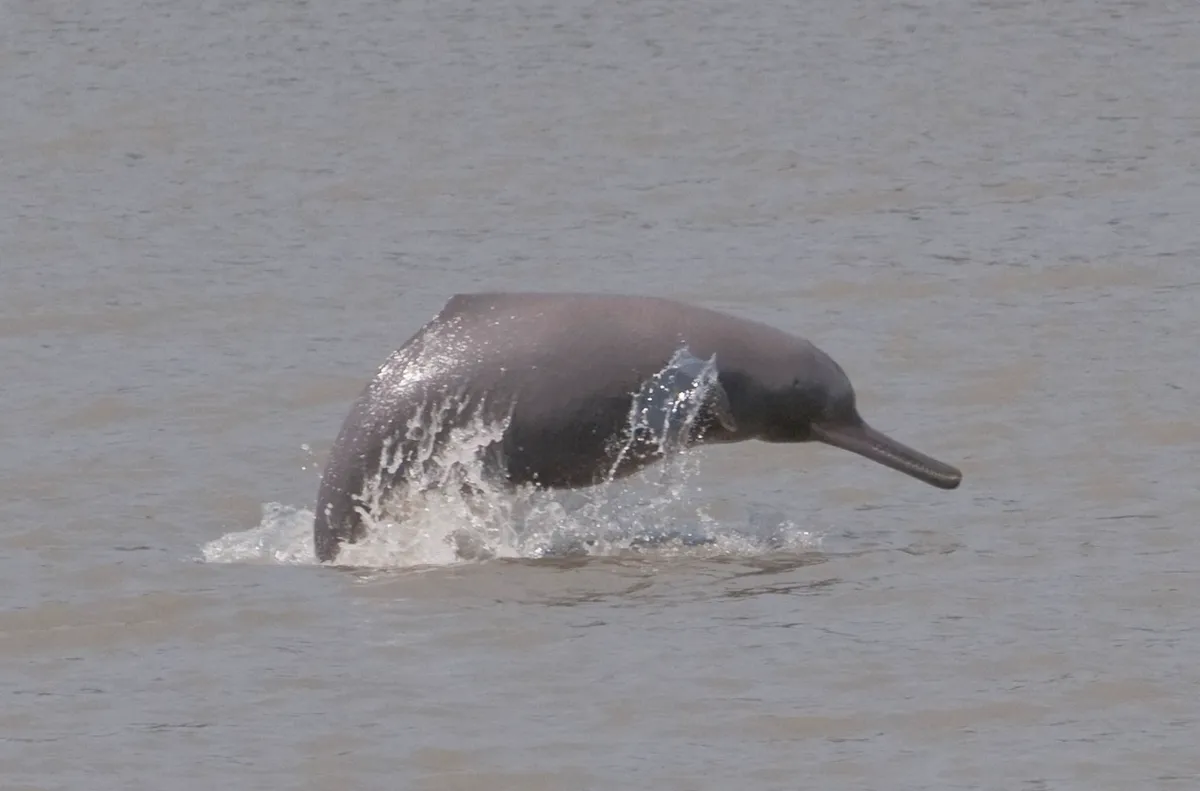A new study led by Dr Gill Braulik of the Sea Mammal Research Unit (SMRU) at the University of St Andrews has classified the river dolphins in South Asia as two separate species, the Indus river dolphin (Platanista minor, pictured above) and the Ganges river dolphin (P. gangetica).
“Recognising the species-level differences between Indus and Ganges river dolphins is extremely important as only a few thousand individuals of each species remain,” says Dr Braulik.
“They have long been regarded as two of the world’s most threatened mammals and my hope is that our findings will bring much-needed attention to these remarkable animals to help prevent them sliding towards extinction.”

Both the Indus and Ganges river dolphins are sometimes referred to as blind dolphins. This is because they live in very muddy waters and have lost their eyesight over millions of years of evolution. To navigate and catch their prey, they must rely completely on echolocation.
The taxonomy of these dolphins has an interesting history, with the dolphins in the Ganges River named Platanista by Pliny the Elder in his Historia Naturalis published around 77AD. The Ganges river dolphin was formally described in 1801, and the Indus river dolphin in 1859. Since then, they have deemed as subspecies or as separate species by various scientists over the years.
In recent decades, an Italian scientist had suggested in the early 1970s that they were two species, which was dismissed by other scientists. Then, from the late 1970s to the late 1990s, they were again deemed to be different species, before being downgraded again to subspecies.
There were a number of difficulties to be tackled by the taxonomists. Comparative studies of the two dolphins are difficult since there are unfriendly international borders, which limit scientists from being able to view both in the wild, and there are few museum specimens, which are often damaged.
This study used the largest set of morphology data to date, as well as new analyses of genetic data and comparison of colouration patterns. In total, 80 skulls were measured, with 29 from the Indus, 45 from the Ganges and six of unknown origin.

Based on their analyses, the scientists concluded that the two dolphins are separate species, and urge that their conservation status be re-examined. Both species are threatened by a range of factors, including pollution, accidental entanglement and drowning in fishing nests, and the construction of hydropower dams and irrigation barrages.
“The rapid decline and extinction of the Yangtze River dolphin this century was a very clear warning: we need to act quickly to protect the remaining species of river dolphins, including the Indus and Ganges, all of which are seriously threatened. The freshwater systems they inhabit must be managed with biodiversity as a top priority,” says Dr Randall Reeves, chair of the IUCN Cetacean Specialist Group.
The Ganges river dolphin population is declining and is estimated at several thousand individuals. In contrast, the Indus river dolphin population has increased from 1,200 in 2001 to almost 2,000 in 2017, after previously declining by 80% in its range.
“The Indus river dolphin recovery in Pakistan is due to decades of dedicated on the ground work with the government authorities and communities and shows what is possible when we work together,” explains Dr Uzma Khan, Asia Coordinator of the WWF river dolphin initiative.
“Serious challenges still face this incredible species and all other river dolphin populations, but we can save them – and by doing so we’ll save so much more since hundreds of millions of people and countless other species depend on the health of river dolphin rivers.”
The conclusion of this new study brings the river dolphin species up to six in total, all of which are listed as either Endangered or Critically Endangered on the IUCN Red List:
- Irrawaddy dolphins (Critically Endangered) - found in the Mekong River, Cambodia, the Ayeyarwady River, Myanmar and the Mahakam River, Indonesia.
- Yangtze finless porpoise (Critically Endangered) - in the Yangtze River, China.
- Amazon river dolphin (Endangered) - in the Amazon and Orinoco Rivers in South America.
- Tucuxi (Endangered) - in the Amazon basin in South America.
- Indus river dolphin (Endangered) - in the Indus River system, Pakistan and India.
- Ganges river dolphin (Endangered) - in the Ganges-Brahmaputra River system, India, Bangladesh and Nepal.

The findings of this study will be put to the Committee on Taxonomy of the Society for Marine Mammalogy, who will make a final decision on the validity of the new species in the next few months.
Read the full paper in Marine Mammal Science.
Main image: An Indus River dolphin in Sukkur, Pakistan. © WWF Pakistan
